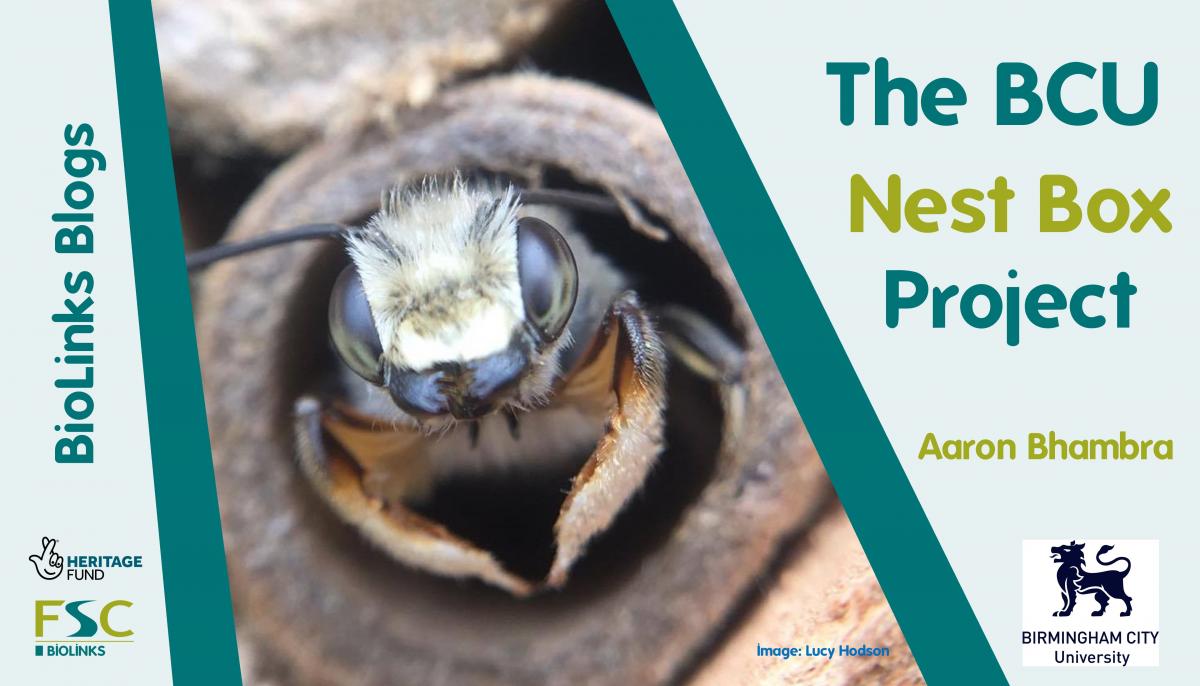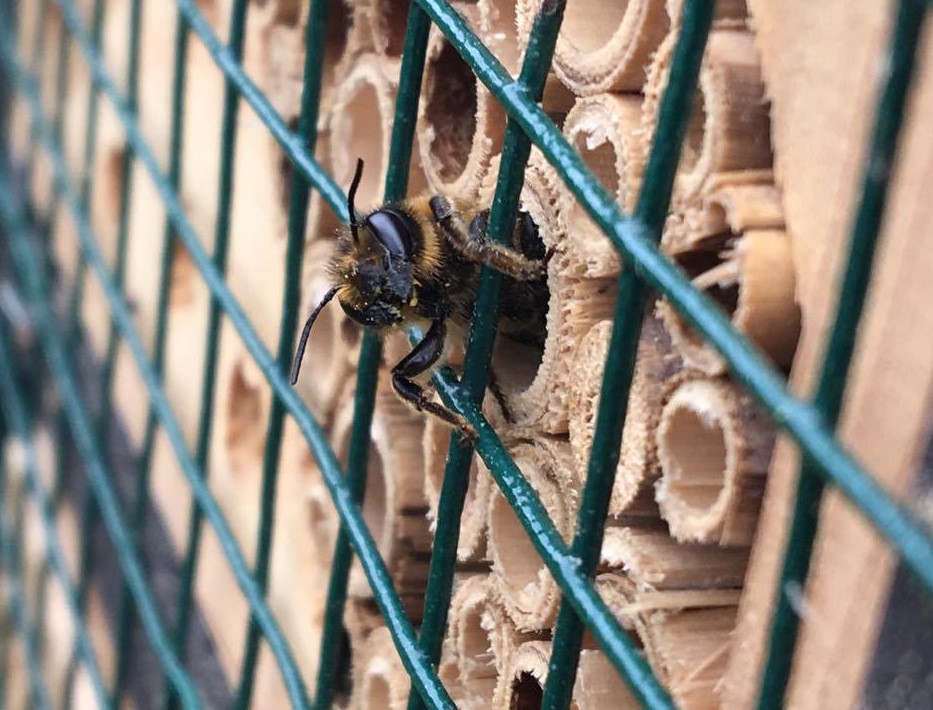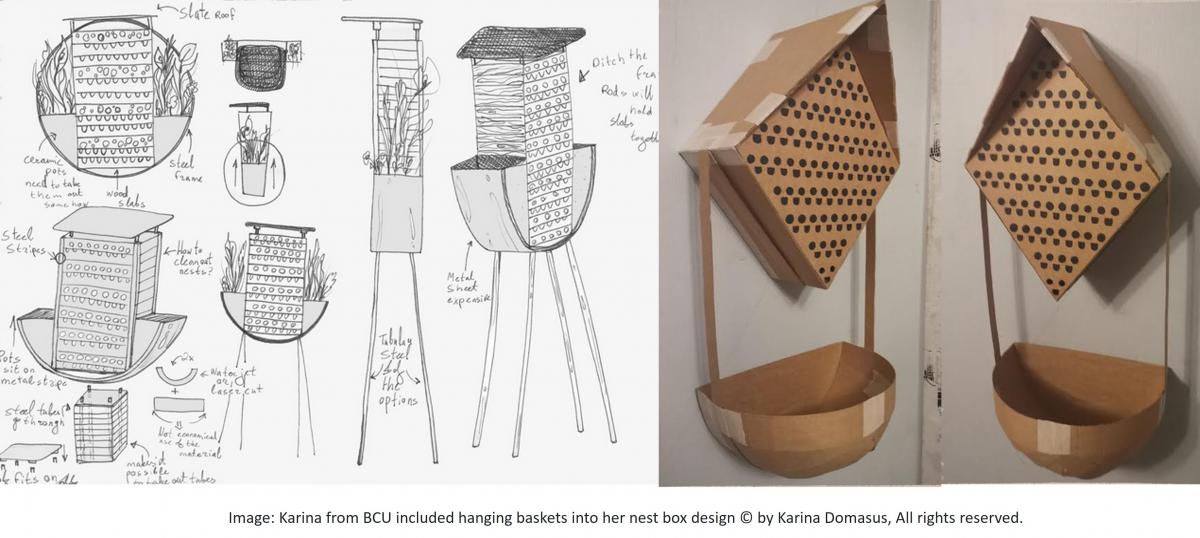The BCU Nest Box Project
 Aaron Bhambra is the Biolinks project officer for the West Midlands and a pollinator specialist with a particular interest in urban conservation and the nesting ecology of solitary bees.
Aaron Bhambra is the Biolinks project officer for the West Midlands and a pollinator specialist with a particular interest in urban conservation and the nesting ecology of solitary bees.
Solitary Bees
There are 20,000 known species of bee in the world and only 1% of those are the social bees which we are all familiar with, which includes the Bumblebees (Bombus) and the Western Honeybee (Apis meliffera). The other 99% are comprised of a myriad mixture of solitary bees. A solitary bee lives a quiet life, rearing several offspring over the course of a year in nesting cells constructed by a single female. This is a very different lifestyle to that of a social bee, which will exist with many other members of a colony. A queen honeybee for example laying 500 eggs per day over the course of many tiresome months.
%20Stephen%20Barlow.jpg)
Image: Ali Rajabali
The vast majority of solitary bees are ground dwelling, living underground in subterranean burrows in substrates like soil, sand and gravel. If you live near the countryside, you’re likely to come across these sand loving, burrow building bees in sandy sites like heathlands or even in your garden during early spring. If you live in an urban area, you might be more likely to come across the other kinds of bees which we have in the UK, the ones that do not burrow underground and will instead make their homes in empty cavities. We call this group of bees, the ‘Cavity Nesters’ as they construct their homes from the pre-existing holes, cracks and crevices built by other animals like wood boring beetles, birds and humans in a process sometimes referred to as 'renting'.
Urban Bees
Urban and rural areas will receive a good mixture of both cavity and ground nesters, but curiously, urban areas tend to favour the proliferation of cavity nesting species more than rural areas, a phenomenon which has been reported in a number of recent studies (Banaszak-Cibicka, 2015 ; Sirioh et al., 2015). Despite the fact that ground nesters make up 52% of the bees in the UK, I would often encounter more cavity nesting species than ground nesters, when carrying out field surveys of invertebrates during my early training as an invertebrate ecologist in Birmingham. The reasons for this are linked to the fact that urban areas offer a greater number of empty cavities due to the human disturbance of the landscape, caused by the perpetual development of the city. These bees will nest in virtually any hollowed out cavities they can find and throughout a bustling city, they will come across cracks in mortar, empty pipes, broken pieces of wood and a host of other suitable nesting locations. It's also possible that cities have a wider appeal to certain bees because of the scattering of floral resources which pepper peoples gardens. As well as the urban-heat island effect, where urban areas tend to be hotter than the surrounding countryside due to the inability of heat to escape the urban core, which could be appealing to thermophillic (heat loving) insects like bees.

Image: Ali Rajabali
Artificial Nest Boxes
Artificial nest boxes (also known as bee hotels, bee boxes and trap nests) can provide nesting space for bees when there are few natural resources available in an environment to support them. They can therefore be an effective tool in the conservation of cavity nesters, aiding both the distribution and population abundance of these tremendously important pollinators.
The utility of these boxes in conserving insects led to the development of the BCU Nest box project, which brought together three organisations and a number of young academics to work out how to design cavity nesting sites for bees. Working with students from the architecture and design department at Birmingham City University, the Biolinks project outlined the current issues associated with commercial nest boxes and attempted to find ways of creating structures which provided increased protection to bee larvae. Students were also keen to create designs which would allow observers to study the behaviour of these insects inside their nest cells and watch how a linear nesting chamber is created, stocked and sealed up, over the course of a season.

Image: Ali Rajabali
Although some commerical nest boxes are perfectly adequate for nesting bees, many sold online and in garden centres throughout the country can be harmful to cavity nesting species. Some do not have the right sized nesting holes or are made from materials which do not protect bee larvae from pests and diseases. Others act as population sinks and allow predators to take advantage of a larder of larvae all neatly packed next to one another. For some, the bottom tips of the nesting tubes are not capped off with solid ends, which allows parasites, fungi and baceteria to easily reach the sleeping larvae inside. Despite this, a well built, regularly managed and strategically placed nest box can be a useful weapon in the fight against bee decline.
The BCU Project
Students from Birmingham City University came up with designs which incorporated wildflowers into the nesting structures to provide bees with nearby nectar & pollen sources.


Others created interlocking wooden pieces around the nesting holes which would make it harder for certain brood parasites to enter nests.

One student even built a perspex screen into her design, which would allow researchers to see directly inside the nesting cells and monitor the behaviour of individual bees as they stocked their chambers. The students researched the natural behaviour of bees to aid them in their designs and incorporated natural features from nesting in the wild to enhance the chance of a successful colonisation. Some students opted to use more man-made materials to see if these could aid the protection of the larvae from harsh weather.

The nest boxes will be created in the workshops of the Birmingham City University campus and will be donated to the Birmingham and Black Country Wildlife Trust, a local conservation charity which aims to improve habitats for wildlife in the region. The habitats will be installed in nature reserves throughout the city and will feed into the monitoring and engagement work of BioLinks as we attempt to investigate the health of bees within the UK’s second city. This is an on-going project which will aim to expand into creating other kinds of habitat designs for invertebrates, such as bumblebee nest boxes and hoverfly rot holes. This project will continue to work with local universities to both engage students with the science of entomology and work towards pioneering solutions for the decline of our nations bees.
Keep up to date with Biolinks courses and events
If you want to keep up to date with BioLinks events , training and courses then subscribe to our Biodiversity Newsletter.
- Anonymous's blog
- Log in or register to post comments


